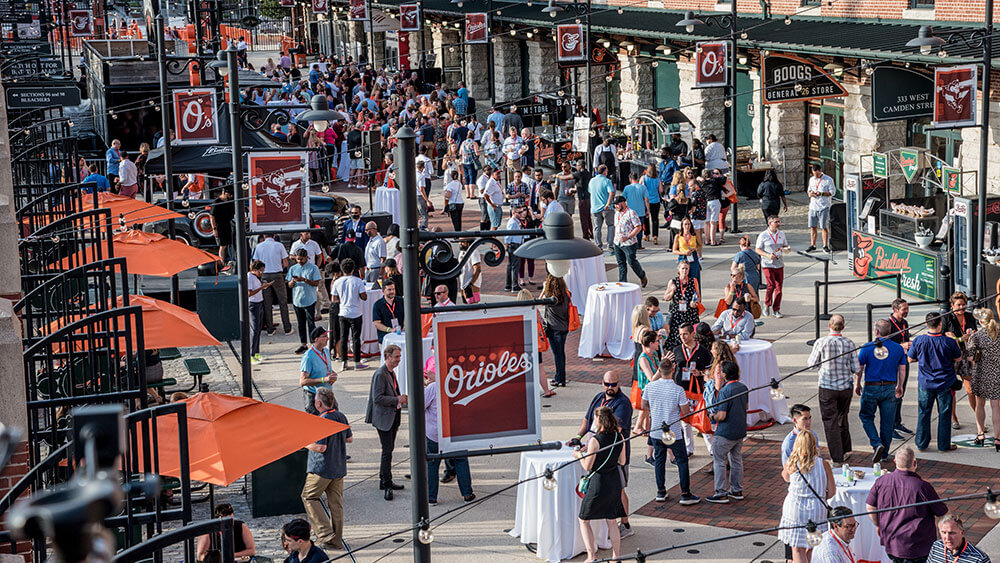
In-person attendees at Destinations International’s annual convention in July gather for a reception at Oriole Park inside Camden Yards in Baltimore. (Visit Baltimore)
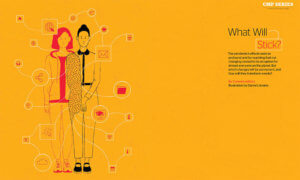
Convene asked individuals from inside and outside the business events industry to talk about behaviors and other changes brought on by the pandemic that are lasting, and in particular, to share which ones they think are likely to transform events. We offer their insights and opinions on this page and in the rest of our July-August CMP Series, What Will Stick?
Bill Grusich: ‘We will see more demand for in-person gatherings.’
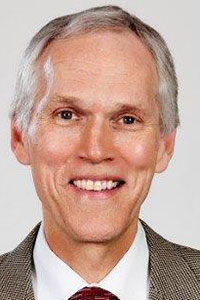
Bill Grusich
The biggest lesson I think we’ve all learned is to no longer take for granted the opportunity and ability to see, learn from, and interact with each other in person. Between the AMC Institute Annual several weeks ago in Orlando and our own three [recent] in-person gatherings in three different cities, the buzz and volume as folks were seeing each other after so long was strong — sometimes deafening, but in a good way. I feel that for quite some time there will be deeper connections made during our in-person events.
I do believe the strength of business events and conferences will be that they are capable of providing networking and knowledge sharing — sometimes one-on-one, at least in smaller groups. That has been the priority of our younger attendees these last few years anyway before the pandemic and I think it will be that way even more so moving forward. I also believe as we get more experience and confidence moving forward that we will see fewer hybrid and virtual options and more demand for in-person gatherings continuing to drive our educational and networking events.
I know that I am looking forward to seeing this great industry getting back on its feet and moving forward!
— Bill Grusich, CMP, FASAE, Senior Vice President, Sales, Associated Luxury Hotels International (ALHI), 2020-2021 PCMA Visionary Award supplier honoree
Ben Goedegebuure: ‘Consumers have had to work differently.’
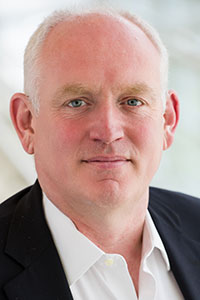
Ben Goedegebuure
We have had to adjust faster to ever-changing and uncertain circumstances, to become more agile, and have had to adapt to constant change. In my view, collaboration has become even more important than ever, within our organizations and with our customers, partners, suppliers, and in some cases, our competitors. To withstand future pressures, we will need to engage with the whole of the business events ecosystem and invest in innovation. Having the strongest possible relations with all stakeholders will be critical for future success.
During the pandemic, consumers have become at ease with online services touching many components of our lives, including digital content provision. Consumers have often had to work differently, engage differently, learn, and spend their leisure time differently. This will undoubtedly have a lasting effect on events, content provision, and society in general. Consumers will want to choose how they consume, work, engage, live. Choice and flexibility will be of critical importance in our lives.
Although society is now more at ease with digital services, we also have become even more aware that humans want to be together to learn, exchange information, and engage — and that there is huge value in human interaction at face-to-face events. As we come out of the pandemic, we have become more cognizant of the fact that we will need to be even more deliberate in our event design, design for different audiences, be prepared to create different and inclusive formats, and provide more choice and opportunity for our audiences. We now have the ability to connect new audiences in new locations who might not be able — or want — to travel, provide flexibility on how participants spend their time at an event (including building wellness components into programming), and provide inclusive events that can address the issues of diverse groups within our target audiences.
— Ben Goedegebuure, Enterprise Vice President, Global & Industry Presence, Maritz Global Events, 2020-2021 PCMA Visionary Award business events strategist honoree.
David Audrain: ‘It’s why car dealers have lots full of cars.’
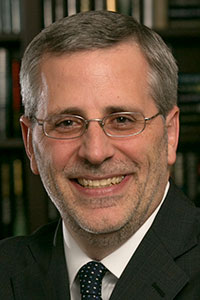
David Audrain
I believe that we have seen several behaviors change that will be long lasting. Consumers now expect to be able to buy almost anything online and have it delivered, and that will likely continue to grow, but they also have realized that they want and value the experience of interacting with people face-to-face. The analogy I would use is concerts and sporting events — you can clearly get a closer and more informed experience watching a sporting event on television or online with close-ups and commentators. The same goes for concerts where you will have better or personalized sound quality and close-ups of performers on television. But people still want to experience the event in person because of its uniqueness and often the group-sharing aspect adds value to them. What we are seeing now is a desire to eliminate the mundane aspects of having simple things done for us and delivered, allowing more time for the in-person experiences that bring the most value.
For business events, it has often been more about the in-person interactions than it has been the about the content. Can I sit in front of a computer and watch a presentation or demonstration? Of course, but most people value the in-person networking and connections, and the “side-discussions” that happen around the conference, and they certainly want to see new products in person. Fashion manufacturers are never going to buy fabric they haven’t touched, equipment buyers want to see equipment run, and feel the quality. It’s why car dealers have lots full of cars for people to sit in and test drive, because they know the tactile, in-person experience will always be far superior to simply looking at a catalog or pictures. What we can do [digitally] however, is expand the access to information pre- and post-event, facilitate better knowledge sharing and planning between buyers and sellers, and enable the events to provide better transactional value to both parties.
— David Audrain, CEO/Executive Director, Society of Independent Show Organizers (SISO)
Don Welsh: ‘It just doesn’t happen magically.’
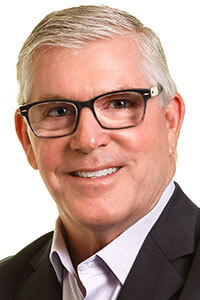
Don Welsh
Clearly, we know that funding for our partners was a major exposed risk when the pandemic began. We had probably a 10-to-12-year-run, in some cases, of double-digit RevPAR increases, record occupancies, which of course flowed to … our members, who are funded in many cases by hotel taxes or visitor tax. But when they went away so dramatically, and there weren’t the necessary reserves, [DMOs] were in pretty dire straits. They did what they could — they immediately cut expenses, did staff reductions. But the reality is you can’t save yourself, in many cases, without having an infusion of money.
We are in the later rounds, if not the last round, of PPP funding, which I know for us and many of our partners and members in the U.S. was a lifeline. Because I think had we not gotten it, the destinations would have probably had to either restructure, they would’ve probably had to get loans from their cities or their states, but they would have had to supplement that loss of revenue.
In terms of the meetings industry, I think we’ve learned a lot. I was a believer that the balance of virtual versus in person would have been a little bit more like 50/50, but looking at our own experience in Baltimore [Destinations International Annual Convention, July 13-15], probably 20-30 percent of our attendance will be virtual. I think when group attendees feel as though it’s safe and affordable and a responsible investment, they will go to that meeting in person.
At the same time, we’re going to continue to see more participation in meetings by having a virtual option. But we all know that when you provide a hybrid environment, there is a double cost with the in-person and virtual piece. It’s a balancing game and we’re all looking at how do we most affordably serve both markets.
I also think that one of the things that’s taken place in most organizations, both corporations and definitely associations, is there’s a lot more conversation amongst the senior team than pre-pandemic to determine who’s going to go to a live meeting in person vs. who’s going to attend virtually. [The challenge is] making sure that the content is super relevant, so it will cause people to say, “Wow, I really need to be there for my continued education.”
A lot of mayors around the world got a real quick understanding of the impact and the importance of their destination organizations during the pandemic, because they immediately had to turn to that local CVB, in many cases, to be the single conduit of having reliable and accurate information about their destination on their website.
I think there are many silver linings that will be sustainable, and that is one. I think the value proposition of a CVB has never been greater in the eyes of their elected officials, and also the local community and key stakeholders. Any time you have the type of sustained success we had — like 10, 12, 15 years — things get taken for granted. I think there’s been a real appreciation and an understanding as to who drives [economic benefit]. It just doesn’t happen magically — there’s an organization that has goals and structure and reporting that a lot of people weren’t aware of existed before now.
There continues to be incredible communication and coordination amongst all the stakeholders. Our engagement with the meetings organizations, our engagement with city government [comes to mind] — probably the biggest investment we made this past year just with the U.S. Conference of Mayors. We got a chance to get in front of 2,000 U.S. mayors.
The slow segment that’s going to come back is business travel. That has been the bread and butter for the hotel industry and the airline industry for decades. They pay the premium airfares, they pay the premium hotel rates, and I think right now that it’s going to take a period of time for them to come back anywhere near the volume they had before.
For many cities, I don’t think they’ll experience full recovery until the meetings and events industry comes back to somewhat pre-pandemic levels. A meeting, an event, is going to be so critical regardless of size for every destination going forward. The meeting planner has never been more important to the recovery of cities.
— Don Welsh, President and CEO, Destinations International
